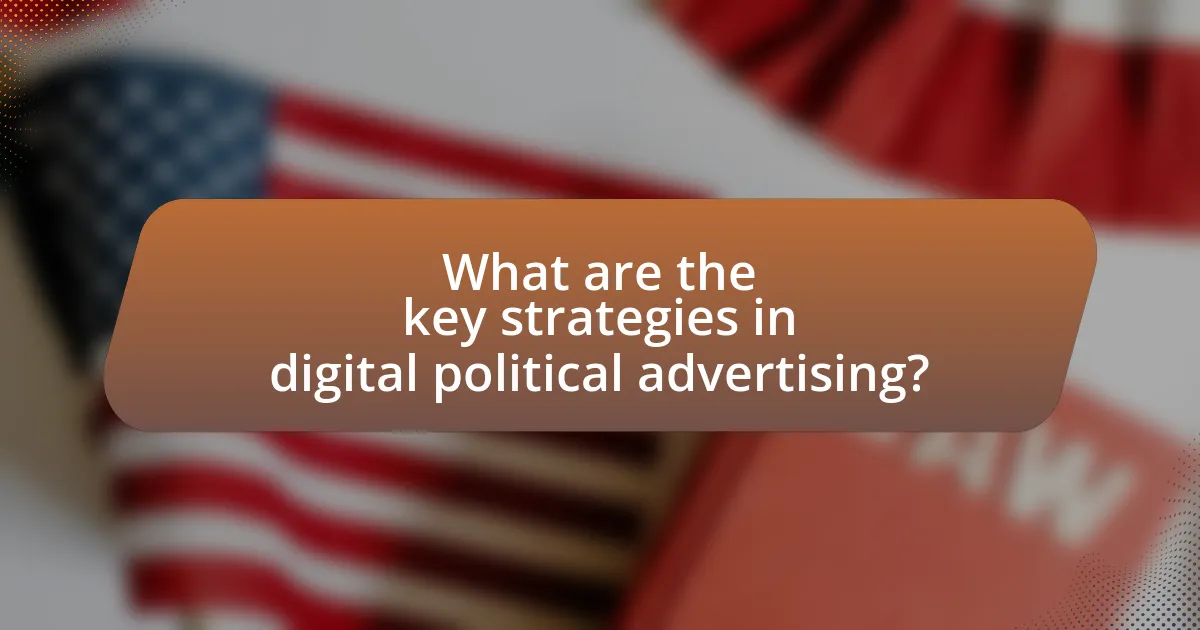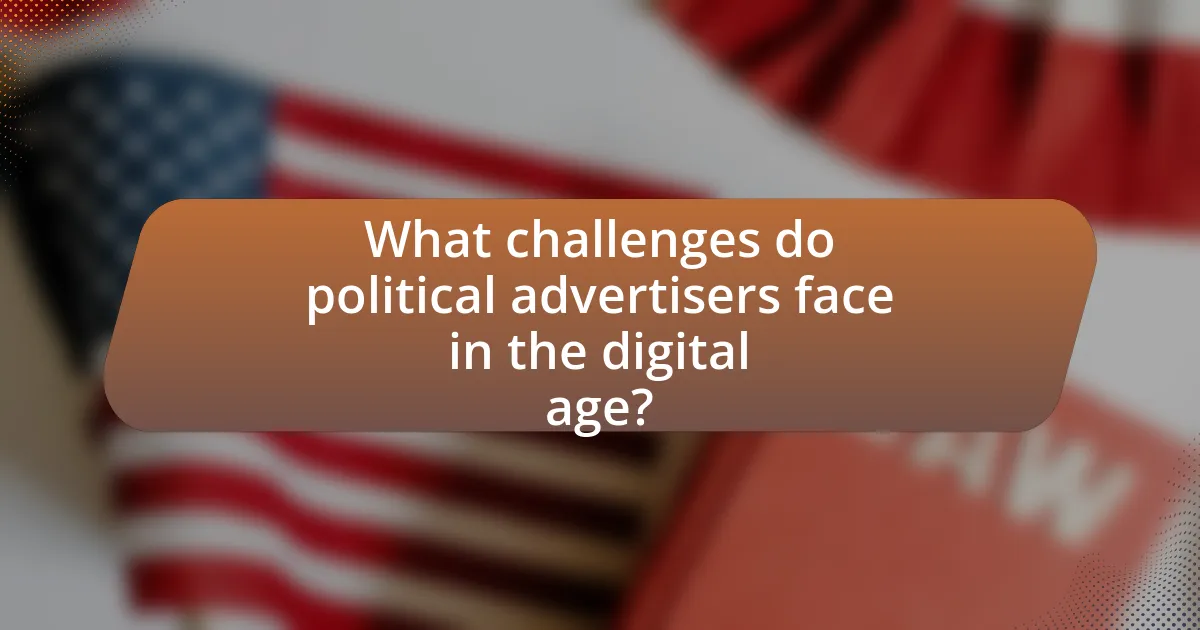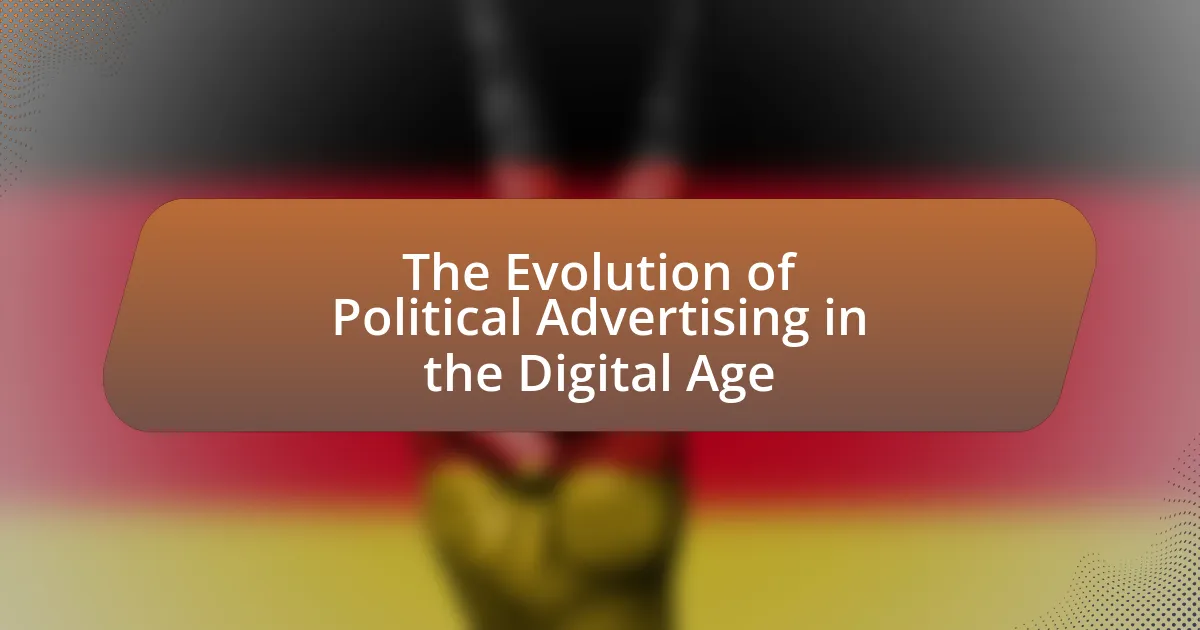The article examines the evolution of political advertising in the digital age, highlighting the transition from traditional media to digital platforms. It discusses key milestones in this evolution, including the impact of social media on voter engagement and the use of data analytics for targeted messaging. The article also addresses the ethical considerations surrounding data usage, the challenges posed by misinformation, and the regulatory landscape governing digital political advertising. Additionally, it outlines best practices for campaigns to effectively engage voters through authentic content and strategic targeting.

What is the Evolution of Political Advertising in the Digital Age?
The evolution of political advertising in the digital age has transformed how campaigns reach and engage voters. Initially, political advertising relied heavily on traditional media such as television, radio, and print, but the advent of the internet and social media platforms has shifted this landscape dramatically. For instance, the 2008 Obama campaign effectively utilized social media to mobilize supporters and target specific demographics, setting a precedent for future campaigns. By 2020, platforms like Facebook and Twitter became essential tools for micro-targeting voters based on their online behavior, allowing campaigns to deliver tailored messages. This shift has also raised concerns about misinformation and the ethical implications of data usage in political advertising, as seen in controversies surrounding the Cambridge Analytica scandal. Overall, the digital age has enabled more direct and personalized political communication, fundamentally changing the strategies employed by political campaigns.
How has political advertising changed with the advent of digital technology?
Political advertising has transformed significantly with the advent of digital technology, shifting from traditional media to targeted online platforms. This change allows campaigns to utilize data analytics for micro-targeting specific demographics, enhancing engagement and effectiveness. For instance, during the 2016 U.S. presidential election, digital ad spending reached approximately $1.4 billion, reflecting a 700% increase from 2012, demonstrating the growing reliance on digital channels. Additionally, social media platforms enable real-time feedback and interaction, allowing campaigns to adjust strategies quickly based on audience reactions. This evolution has fundamentally altered how political messages are crafted and disseminated, making them more personalized and immediate.
What are the key milestones in the evolution of political advertising?
The key milestones in the evolution of political advertising include the introduction of print media in the 18th century, the use of radio and television in the 20th century, and the rise of digital platforms in the 21st century. Print media allowed candidates to reach a broader audience through pamphlets and newspapers, significantly impacting early political campaigns. The advent of radio in the 1920s enabled candidates to connect with voters through direct communication, exemplified by Franklin D. Roosevelt’s “Fireside Chats.” Television further transformed political advertising in the 1960s, with John F. Kennedy’s televised debates against Richard Nixon showcasing the medium’s power to influence public perception. In the 2000s, the emergence of the internet and social media platforms revolutionized political advertising, allowing for targeted messaging and real-time engagement with voters, as seen in Barack Obama’s 2008 campaign, which effectively utilized digital strategies to mobilize support. These milestones illustrate the ongoing transformation of political advertising in response to technological advancements and changing voter behaviors.
How do digital platforms differ from traditional media in political advertising?
Digital platforms differ from traditional media in political advertising primarily through their targeting capabilities and interactivity. Digital platforms allow for precise audience segmentation based on user data, enabling advertisers to reach specific demographics with tailored messages, while traditional media, such as television and print, generally offer broader, less targeted reach. For instance, a study by the Pew Research Center found that 69% of Americans use social media, which provides political advertisers with the opportunity to engage directly with voters through interactive content, unlike the passive consumption of traditional media. Additionally, digital platforms facilitate real-time feedback and engagement, allowing campaigns to adjust their strategies quickly based on audience reactions, a flexibility that traditional media lacks.
Why is understanding this evolution important for modern campaigns?
Understanding the evolution of political advertising is crucial for modern campaigns because it informs strategies that effectively engage voters in a digital landscape. As political advertising has transitioned from traditional media to digital platforms, campaigns must adapt to new consumer behaviors and preferences, which are increasingly shaped by social media and online interactions. For instance, a study by the Pew Research Center indicates that 69% of adults in the U.S. use social media, making it a vital channel for reaching potential voters. This evolution also highlights the importance of data analytics in targeting specific demographics, allowing campaigns to tailor their messages for maximum impact. Therefore, grasping this evolution enables campaigns to leverage technology and data-driven insights to enhance voter engagement and influence electoral outcomes.
What impact does digital advertising have on voter engagement?
Digital advertising significantly enhances voter engagement by providing targeted messaging and real-time interaction opportunities. Research indicates that campaigns utilizing digital platforms can reach specific demographics more effectively than traditional media, leading to increased voter awareness and participation. For instance, a study by the Pew Research Center found that 69% of adults in the U.S. use social media, which political campaigns leverage to engage voters directly through tailored content and advertisements. This targeted approach not only informs voters about candidates and issues but also encourages them to participate in the electoral process, as evidenced by higher turnout rates among those exposed to digital campaign efforts.
How does the evolution of political advertising influence public perception?
The evolution of political advertising significantly influences public perception by shaping how voters receive and interpret information about candidates and issues. As political advertising has transitioned from traditional media, such as television and print, to digital platforms, it has allowed for more targeted messaging and real-time engagement with audiences. For instance, the 2008 Obama campaign effectively utilized social media to mobilize young voters, resulting in a 66% turnout rate among 18-29 year-olds, compared to 50% in 2004. This shift not only enhances the immediacy of political messages but also fosters a more personalized connection between candidates and constituents, ultimately altering public attitudes and voting behavior.

What are the key strategies in digital political advertising?
Key strategies in digital political advertising include targeted messaging, data analytics, social media engagement, and multimedia content creation. Targeted messaging allows campaigns to reach specific demographics based on data insights, enhancing relevance and effectiveness. Data analytics plays a crucial role in measuring campaign performance and optimizing strategies in real-time, as evidenced by the use of A/B testing to refine ad content. Social media engagement fosters direct communication with voters, enabling campaigns to build communities and respond to public sentiment quickly. Multimedia content creation, including videos and interactive graphics, captures attention and conveys messages more effectively, as seen in successful campaigns that utilize platforms like YouTube and Instagram to reach younger audiences.
How do campaigns utilize social media for political advertising?
Campaigns utilize social media for political advertising by creating targeted advertisements that reach specific demographics based on user data. This approach allows campaigns to engage with potential voters through tailored messages, leveraging platforms like Facebook, Twitter, and Instagram to maximize outreach. For instance, during the 2020 U.S. presidential election, candidates spent over $1 billion on social media ads, demonstrating the effectiveness of this strategy in influencing voter behavior. Additionally, social media enables real-time interaction and feedback, allowing campaigns to adjust their messaging quickly based on audience response, further enhancing their advertising effectiveness.
What are the most effective platforms for political messaging?
The most effective platforms for political messaging are social media networks, particularly Facebook, Twitter, and Instagram. These platforms enable direct engagement with voters, allowing for targeted advertising and real-time interaction. According to a 2020 Pew Research Center study, 69% of adults in the U.S. use Facebook, making it a crucial platform for reaching a broad audience. Additionally, Twitter’s fast-paced environment facilitates rapid dissemination of messages, while Instagram’s visual content appeals to younger demographics. These characteristics enhance the effectiveness of political messaging by fostering community engagement and increasing visibility.
How do campaigns tailor their messages for different demographics on social media?
Campaigns tailor their messages for different demographics on social media by utilizing data analytics to understand audience preferences and behaviors. By analyzing demographic data such as age, gender, location, and interests, campaigns can create targeted content that resonates with specific groups. For instance, younger audiences may respond better to visual content and memes, while older demographics might prefer informative articles or videos. Research indicates that personalized messaging can increase engagement rates significantly; for example, a study by the Pew Research Center found that 70% of social media users are more likely to engage with content that reflects their interests and values. This strategic approach ensures that campaigns effectively communicate their messages to diverse audiences, maximizing impact and reach.
What role does data analytics play in political advertising?
Data analytics plays a crucial role in political advertising by enabling campaigns to target specific voter demographics with precision. Through the analysis of vast amounts of data, political advertisers can identify trends, preferences, and behaviors of potential voters, allowing for tailored messaging that resonates with different segments of the electorate. For instance, the 2016 U.S. presidential election saw campaigns utilizing data analytics to micro-target ads based on individual voter profiles, significantly increasing engagement and conversion rates. This strategic use of data not only enhances the effectiveness of advertising efforts but also optimizes budget allocation by focusing resources on the most promising voter segments.
How do campaigns gather and analyze voter data?
Campaigns gather and analyze voter data through various methods, including surveys, social media analytics, and voter registration databases. Surveys allow campaigns to collect direct feedback from potential voters about their preferences and concerns. Social media analytics provide insights into voter sentiment and engagement by tracking interactions and discussions on platforms like Twitter and Facebook. Voter registration databases offer demographic information, enabling campaigns to segment and target specific voter groups effectively. According to a 2020 study by the Pew Research Center, 69% of Americans use social media, making it a crucial tool for campaigns to understand and engage with the electorate.
What ethical considerations arise from data usage in political advertising?
Data usage in political advertising raises significant ethical considerations, primarily concerning privacy, manipulation, and misinformation. Privacy issues arise when personal data is collected without explicit consent, leading to potential violations of individuals’ rights. For instance, the Cambridge Analytica scandal highlighted how data from millions of Facebook users was harvested for targeted political ads without their knowledge, raising concerns about informed consent and data ownership.
Manipulation is another ethical concern, as data analytics can be used to exploit psychological vulnerabilities, tailoring messages that may mislead or coerce voters. Research indicates that targeted ads can influence voter behavior by presenting biased information, which undermines democratic processes.
Furthermore, misinformation campaigns, often facilitated by data-driven strategies, can distort public perception and erode trust in political institutions. The spread of false information through targeted ads has been documented in various elections, demonstrating the potential for data usage to harm the integrity of democratic discourse.
These ethical considerations underscore the need for regulatory frameworks to ensure responsible data practices in political advertising.

What challenges do political advertisers face in the digital age?
Political advertisers face significant challenges in the digital age, primarily due to the rapid evolution of technology and changing consumer behaviors. The proliferation of social media platforms complicates targeting and message delivery, as algorithms frequently change, impacting ad visibility and effectiveness. Additionally, issues related to data privacy and regulations, such as the General Data Protection Regulation (GDPR) in Europe, restrict how advertisers can collect and utilize consumer data, limiting their ability to create personalized campaigns. Furthermore, the rise of misinformation and the challenge of maintaining credibility in a crowded digital landscape make it difficult for political advertisers to convey their messages effectively. These factors collectively hinder the ability of political advertisers to reach and engage their target audiences efficiently.
How do misinformation and fake news impact political advertising?
Misinformation and fake news significantly distort political advertising by misleading voters and shaping public perception. Political campaigns often leverage social media platforms where misinformation spreads rapidly, leading to the dissemination of false narratives that can influence electoral outcomes. For instance, a study by the Pew Research Center found that 64% of Americans believe fabricated news stories cause confusion about the basic facts of current events, which directly affects how voters interpret political messages. This manipulation can undermine trust in legitimate political advertising and create an environment where voters are swayed by sensationalized or false information rather than factual content.
What strategies can campaigns employ to combat misinformation?
Campaigns can employ fact-checking, transparency, and audience engagement strategies to combat misinformation. Fact-checking involves verifying claims made in political advertising and providing accurate information to counter false narratives, as seen in initiatives like the Poynter Institute’s PolitiFact, which has fact-checked over 15,000 statements since its inception. Transparency includes disclosing funding sources and the origins of information, which builds trust with the audience; for instance, the Ad Transparency Center by Facebook allows users to see the funding behind political ads. Audience engagement strategies, such as interactive content and community discussions, encourage critical thinking and help audiences discern credible information, as demonstrated by the success of platforms like Reddit in fostering informed dialogue.
How does the public’s trust in digital media affect political advertising effectiveness?
The public’s trust in digital media significantly impacts the effectiveness of political advertising. When trust levels are high, audiences are more likely to engage with and believe the messages conveyed in political ads, leading to increased persuasion and voter mobilization. Conversely, low trust in digital platforms can result in skepticism towards political advertisements, diminishing their impact and effectiveness. Research indicates that in the 2020 U.S. elections, 70% of voters expressed concerns about misinformation on social media, which directly correlated with reduced trust in political ads, ultimately affecting voter behavior and campaign outcomes.
What regulations govern political advertising in the digital space?
Regulations governing political advertising in the digital space primarily include the Federal Election Commission (FEC) rules, the Communications Act, and various state laws. The FEC mandates that political advertisements disclose their sponsors and adhere to contribution limits, ensuring transparency in funding. The Communications Act requires that broadcasters maintain records of political ad purchases, while state laws may impose additional requirements, such as registration and reporting for online political ads. These regulations aim to promote accountability and prevent misinformation in digital political campaigning.
What are the key laws and guidelines that campaigns must follow?
Campaigns must follow key laws and guidelines such as the Federal Election Commission (FEC) regulations, which govern campaign finance, and the Communications Act, which mandates truthful advertising. The FEC requires campaigns to disclose contributions and expenditures, ensuring transparency in funding sources. Additionally, the Communications Act prohibits false or misleading statements in political advertising, holding campaigns accountable for the accuracy of their claims. These regulations are designed to promote fair competition and protect voters from deceptive practices in political advertising.
How do these regulations vary across different countries?
Regulations on political advertising vary significantly across countries, influenced by cultural, legal, and political contexts. For instance, the United States allows extensive political advertising with minimal restrictions, governed primarily by the Federal Election Commission, which mandates transparency in funding but permits substantial spending by individuals and organizations. In contrast, countries like Germany impose stricter regulations, including limits on campaign financing and mandatory disclosure of funding sources, reflecting a commitment to equitable electoral processes. Additionally, in the United Kingdom, the Electoral Commission oversees political advertising, enforcing rules on spending limits and requiring clear labeling of political content. These differences illustrate how national values and political systems shape the regulatory landscape for political advertising globally.
What best practices should campaigns follow for effective digital political advertising?
Campaigns should prioritize targeting, transparency, and engagement for effective digital political advertising. Targeting involves utilizing data analytics to reach specific demographics, ensuring that messages resonate with the intended audience. Transparency is crucial; campaigns must disclose funding sources and ad placements to build trust with voters. Engagement strategies, such as interactive content and social media outreach, foster a two-way communication channel, allowing voters to connect with candidates. According to a study by the Pew Research Center, targeted ads can increase voter engagement by up to 30%, highlighting the importance of these best practices in maximizing campaign effectiveness.
How can campaigns create authentic and engaging content for voters?
Campaigns can create authentic and engaging content for voters by leveraging storytelling that resonates with their target audience’s values and experiences. This approach fosters a genuine connection, as evidenced by the success of campaigns that utilize personal narratives and relatable scenarios, which have been shown to increase voter engagement. For instance, the 2008 Obama campaign effectively used personal stories in its digital content, resulting in a significant increase in grassroots support and volunteer participation. By focusing on real-life implications of policies and encouraging voter interaction through social media platforms, campaigns can enhance authenticity and engagement, ultimately leading to a more informed electorate.
What are the common pitfalls to avoid in digital political advertising?
Common pitfalls to avoid in digital political advertising include lack of targeting, insufficient compliance with regulations, and failure to engage with the audience. Lack of targeting can lead to wasted resources, as ads may reach individuals who are not potential voters; for instance, a study by the Pew Research Center found that targeted ads significantly increase engagement rates. Insufficient compliance with regulations, such as failing to disclose funding sources, can result in legal repercussions and damage to credibility, as seen in various political campaigns that faced scrutiny for transparency issues. Lastly, failure to engage with the audience can result in low interaction rates; research indicates that campaigns that actively respond to constituents on social media see higher levels of voter engagement.
